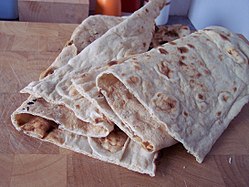This article needs additional citations for verification .(December 2018) |
 Manda roti being prepared on an upturned vessel | |
| Alternative names | Mandige, rumali, or veechu roti |
|---|---|
| Place of origin | |
| Associated cuisine | Indian and Pakistani |
| Main ingredients | Atta and maida flour |
Manda roti (also called rumali roti) is a traditional Indian and Pakistani bread. They can be made with cardamom, ghee, sugar and milk. This roti is extremely thin and limp, and served folded like a handkerchief. Manda roti is usually made with a combination of whole-wheat atta flour and white wheaten maida flour and cooked on the convex side of a kadahi. It is also known as veechu roti in Tamil or mandige [1] in other parts of South India.


